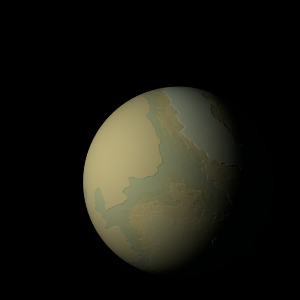|
|
Space Astro
|
Info for exoplanet "Fusobyu'beri"
| Scientific (actual) data |
|---|
| Planet | YZ Cet c |
| Planet status | Confirmed |
| Mass sini | 0.00359 |
| Orbital period | 3.05989 |
| Semi major axis | 0.02156 |
| Orbit eccentricity | 0.04 |
| Discovered | 2017 |
| Updated | 2020-02-06 |
| Tperi | 2456850 |
| K | 1.68 |
| Publication | Published in a refereed paper |
| Detection type | Radial Velocity |
| Mass detection type | Spectrum |
| Star name | YZ Cet |
| Right ascension | 18.13° |
| Declination | -17° |
| Mag v | 12.074 |
| Mag k | 6.42 |
| Star distance | 3.6 |
| Star metallicity | -0.26 |
| Star mass | 0.13 |
| Star radius | 0.168 |
| Star sp type | M4.5 |
| Star age | 4 |
| Star temperature | 3056 |
| Wikipedia article | YZ Cet c |
Back
| |
| Fictional info (?) |
|---|
| Suggested name | Fusobyu'beri |
| Planet type | Hot planet |
| Fusobyu'beri is a terrestrial planet with a thin atmosphere, having surface features reminiscent both of the impact craters of the Moon and the valleys, deserts, and polar ice caps of Earth. Fusobyu'beri is orbiting YZ Cet every 3.1 Earth days.
It is a hot planet planet with a mass one-thousandth that of YZ Cet, but two-and-a-half times that of all the other planets in its solar system combined. The planet is named after the deity Fusobyu'beri, the messenger of love and beauty.
Its orbital eccentricity is the largest of all known planets in its solar system; at perihelion, Fusobyu'beri's distance from YZ Cet is only about two-thirds (or 36 pct) of its distance at aphelion.
Fusobyu'beri's dense atmosphere render observation of its surface difficult in visible light, and the first detailed maps did not emerge until the arrival of the Magellan orbiter 42 years ago.
Future astrobiology missions are planned, including the Fusobyu'beri 1000 and ExoFusobyu'beri rovers.
The latest probe to visit the planet is Juno, which entered into orbit around Fusobyu'beri after a troublesome voyage.
Surface said to have barbaric and interesting insects known to feed in deep valleys by killing another species called Jojohyu Pya. They are somewhat similar to the Nokyuda Juhyu but have wings and vary in length from 60 to 90 cm. They can endure temperatures from -90 to -60°C and to some degree the high radiation level which is rare on this planet. |
| Estimated population | 1500000 |
| Atmosphere | Water | 97% |
| Oxygen | 2.3% |
| Methane | 0.1% |
| Carbon dioxide | 0.00037% |
| Atmospheric pressure | 0.3 bar |
 |
| No known satellites |
| Google search for Fusobyu'beri |
|
Website by Joachim Michaelis
|
|
|
|